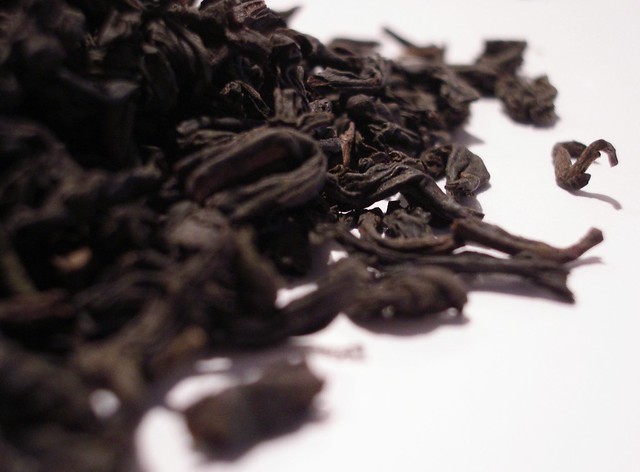 Coarse leaves of lapsang souchong tea. Photo by Selva.
Coarse leaves of lapsang souchong tea. Photo by Selva.
You may have noticed the trend, in the fancy ice cream freezer at the grocery store, for bright green pints of “Green Tea Ice Cream.” The color, and flavor, comes from matcha, the green tea powder that is traditionally used in Japanese tea ceremonies. Although the use of matcha in confections is recent, the idea of tea-flavored ice cream is quite old.
Drinks, like tea, coffee, and “hot” chocolate, were some of the earliest ice cream flavors, first appearing in the 18th century. This recipe for Howqua’s-Tea Ice Cream, from The Ice Book, 1844, particularly captured my imagination.
Basic Custard Ice Cream
-
2 cups heavy whipping cream
-
1 cup whole milk
-
1 vanilla bean (or, other flavoring of your choice)
-
6 large egg yolks
-
3/4 cup sugar
-
1/4 teaspoon coarse salt
-
Additional mix-ins
Add split and scraped vanilla bean to cream and milk in a saucepan. Bring to a boil. In the meantime, in a glass bowl whisk together egg yolks, sugar and salt until blended. After cream mixture comes to a boil, pour slowly on the egg mixture, whisking constantly. Return to saucepan and cook over low heat, stirring constantly with a wooden spoon, until custard thickens slightly and evenly coats back of spoon (it should hold a line drawn by your finger). Pour custard through a fine-mesh sieve into a bowl set over ice, or place in refrigerator, until chilled–overnight is preferable. Churn in an ice-cream maker according to manufacturer’s instructions, adding mix-ins like nuts or fruits in the last few minutes of freezing. Transfer ice cream to a resealable plastic container and freeze until firm, about 2 hours.
I learned about Howqua’s Ice Cream from Ivan Day’s Ice Cream: A History (Shire Library)

I always have some Lapsang Souchong tea in my tea cabinet (mainly because I bought a 1/4 pound a long while ago (2000?) and only a few leaves at a time to a measure of ‘normal’ black tea when I want a slightly smoky flavor). One day I ran across a recipe in Elizabeth Andoh’s “Washoku” for a salad of cucumbers, wakame, and diakon sprouts that included a “smoky vinaigrette.” The smoke in that vinaigrette came from bonito flakes, but since I don’t eat fish, I thought I’d try the Lapsang Souchong. As the recipe recommends, I warmed rice vinegar, sugar, salt and kombu in a saucepan to dissolve the salt & sugar, then deviated by adding some Lapsan Souchong and letting it steep for a few minutes before straining. It worked! The vinaigrette was nicely smoky.
I thought this post is for howquas tea ice cream, but I don’t see tea listed in the ingredients or in the instructions of the custard ice cream recipe.
” I used my standard custard ice cream recipe (below) and infused the milk and cream with 1/4 cup of loose leaf lapsang souchong tea.”
How do you infuse? Do you put the tea leaf into cold or hot milk? How long do you infuse the leaf? (5 minutes, 24 hours, etc?)